Updated: 03-Mar-2022
Rateau was a designer and manufacturer of compressors, fans, pumps and turbines, whose devices have been coupled to multiple engines and airplanes with which records of altitude, speed, etc. have been achieved.
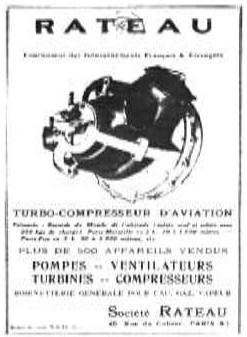
“Rateau ad”
-The turbochargers used in aviation were famous long before they were commonly used by land vehicles, already in our times.
-Although the company's official address was within Paris, the factory was located between Le Bourget and the capital, in Le Courneuve.
- Already in 1917 its turbocharger was famous. So were the steam turbines they built.
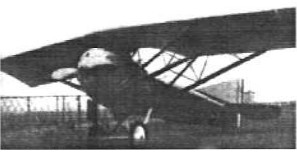
“Gourdon-Lesseure airplane”
-In 1924 a Rateau turbocharger installed on a 300 hp Hispano-Suiza of the Gourdon-Lesseure aircraft broke the altitude record.
-For a long time the general manager was Mr. René Anxionnaz, inspirer of many ideas carried out at Rateau.
-In 1939, gas turbines were already being studied, disconnected from the English and German advances.
-Below we show a rear view of the Gnome Rhone engine, licensed from the Bristol Jupiter, but with a feeding system designed by Rateau, consisting of a mechanical supercharger and a power distribution made up of multiple conduits to act as coolers (radiators or intercoolers).
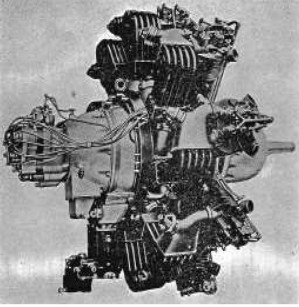
“Jupiter with Rateau supercharger”
-We go back to times gone by to present a Farman seen from behind with a mechanical supercharger from Rateau.
-It is an 18 WI with the 18 cylinders in inverted W, with a power of 600-700 CV.
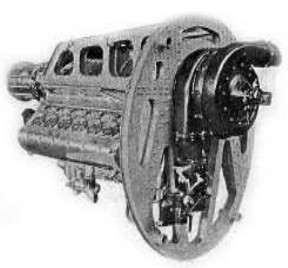
“Farman engine with Rateau supercharger”
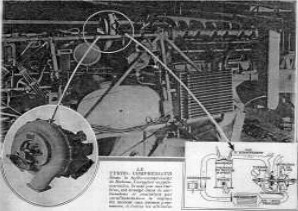
"Rateau Turbocharger on a V-12"
-During the German occupation of WWII, dispersed, engineers continued studying turbines, without connecting between them, in full secrecy to avoid arrests.
-After the war, they met again and developed the SRA-1 that would run in 1947.
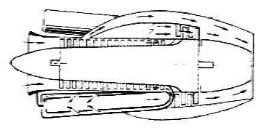
“GT S-65”
-But, as disclosed, one of the first French turbines was the Rateau GT S-65, an ingenious turbine that could be considered an engine and nacelle together.
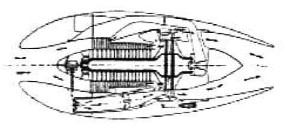
“GT S-65, with nacelle”
-It was built shortly after the war, with nine combustion chambers in a singular, reverse position.
-After making several turns, the air flow at its outlet from the 16-stage compressor enters the combustion chambers and returns to drive the two-stage turbine.
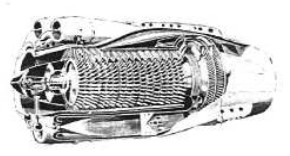
"Splendid cutaway of the S-65"
-The production was commissioned by recently founded Snecma, which brought together almost the entire French aeronautical engine industry.
-Finally we see the Rateau GT S-65 in an aeronautical exhibition stand, next to turbochargers and superchargers, behind it.
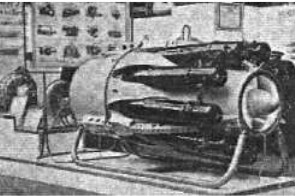
“Rateau GT S-65”
-The fact that the engines built by Rateau were identified as SRA was by the initials of “Societé Rateau Anxionnaz”.
-We show a slightly closer photo of the same engine, in the same exhibition. It consists of the nine-combustion-chamber turbojet that we illustrate here as projected by this company in 1939.

“Rateau SRA-65 engine”
-The next known engine of the brand was the SRA-101, which also bore the nickname of "Savoie".
-Later other names have appeared for as many engines as “Berry” (in jet and double flow version) and another known as “Idole”.
-The "Savoie" contained a 10-stage axial compressor.
-Air from the compressor was diverted through ducts around the engine over the combustion chambers in a test of a “sui-generis” By-pass.
-It was not well calculated and the engine was never manufactured. There were internal aerodynamic errors.
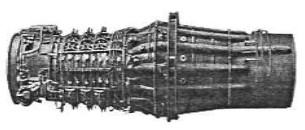
“SRA-101, Savoie”
-Fruit of the imagination of René Anxionnaz was the idea of a reverse for braking, diverting the gases forward, as we see in figure 1.
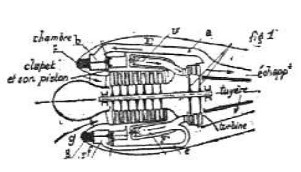
“Figure 1”
-It was based on the S-65 engine, this idea consisted of valves located on the edge of the engine's front inlet ring, which when opened, pushed a part of the gas jet forward.
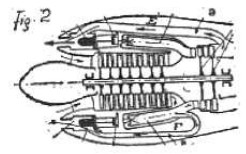
“Figure 2”
-In figure 2 we see the open valves, letting the gas jets come out in the opposite direction to the forward movement of the engine (and the plane).
-Viewed from the front, the engine looked like figure 3, with a hole-in-the-wall crown for that matter.

“Figure 3”
-Remember that on the subject of superchargers, they supplied Renault (see) or Potez, to the point that the 12As model was known as Rateau-Potez.
-Reviewing the projects and patents, then, we have the following new schematics: Rateau's turbojet projects have been known since 1939, all of them double flow.
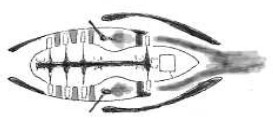
"Rateau double flow patent"
-In the above illustration we see that the air induced at the height of the chambers is taken to the hot outlet jet as a thrust booster.

"Double compressor patent"
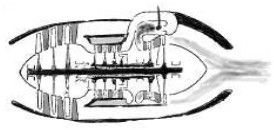
"Double shaft and double compressor"
-This illustration shows us that in 1939 there was already the concept of a double compressor (HP and LP), double flow and inverted chambers, like so many current engines.
-We have been sent an illustration of the SRA-1 that is mentioned in the main text.

“SRA-1”
-Another drawing of the SRA-1, or A-65 inside a nacelle fairing of a multi-engine aircraft, below.
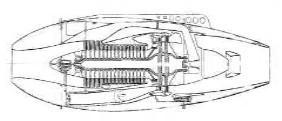
“SRA-1 in nacelle”
-This is the predecessor of the S-65 that we already know. The idea of single and inverted chambers would stick around for a few more projects such as the 1946 SRA IV-G contra-rotating twin-propeller turboprop.
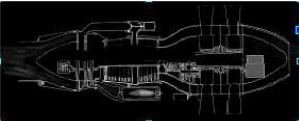
“Rateau turboprop” (PiP)
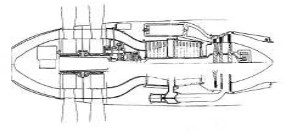
“Another view of Rateau's turboprop”
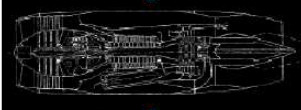
“SRA-3” (PiP)
-We have also been offered an engine presented as the “Berry” SRA-3. As we can see, it still has the reversed chambers. There is an afterburner in the nozzle and a movable cone.
-Between the two front compressors there is a reducer for the front, acting like today's "fan" although with three stages.

“SRA-301 ?” (PiP)
-At the same time as the previous one, we have been offered this engine, more classic and like the SRA-301 with 4,500 Kgf of thrust.
-We therefore continue without having news of the "Idole". Rateau jet either, see main text.
Engines of RATEAU
Model: GT, S-65
Arquitecture:
Compressor/s:
Combustion chambers:
Turbines:
Power / Thrust: / ---
Weight:
Model: SRA-1
Arquitecture:
Compressor/s:
Combustion chambers:
Turbines:
Power / Thrust: / ---
Weight:
Model: SRA-101 “Savoie”
Arquitecture:
Compressor/s:
Combustion chambers:
Turbines:
Power / Thrust: / ---
Weight:
Model: SRA-3 “Berry”
Arquitecture:
Compressor/s:
Combustion chambers:
Turbines:
Power / Thrust: / ---
Weight:
Model: SRA-301
Arquitecture:
Compressor/s:
Combustion chambers:
Turbines:
Power / Thrust: / ---
Weight:
Model: SRA-IV-G
Arquitecture:
Compressor/s:
Combustion chambers:
Turbines:
Power / Thrust: / ---
Weight:
Model: SRA-XX “Idole”
Arquitecture:
Compressor/s:
Combustion chambers:
Turbines:
Power / Thrust: / ---
Weight:


